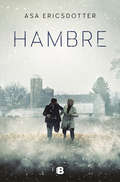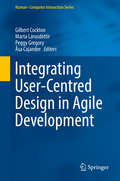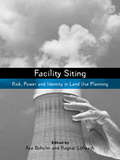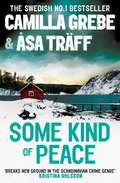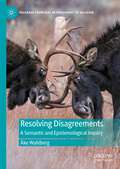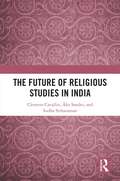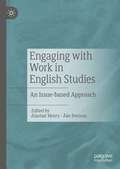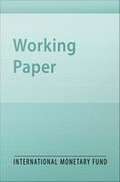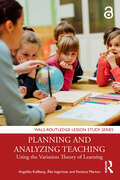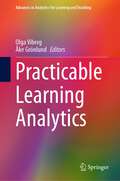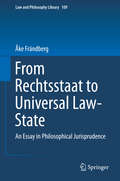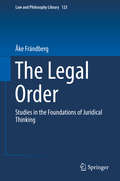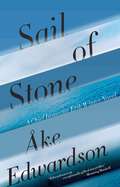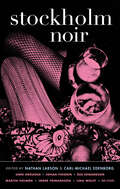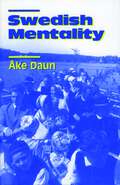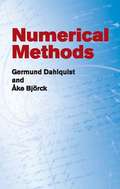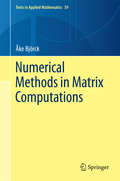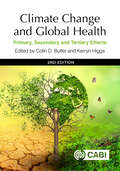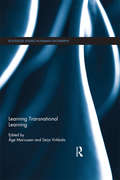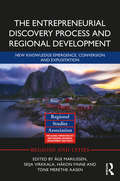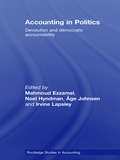- Table View
- List View
Hambre
by Åsa EricsdotterCONTROLAN TU VIDA, TU PESO, TU SALUD. NO TIENES ESCAPATORIA. Una distopía inquietante. Un thriller aterrador. El primer ministro de Suecia ha emprendido una política radical: erradicar la obesidad y el sobrepeso de la población. El objetivo es un país libre de grasa, y los métodos para conseguirlo son cada vez más expeditivos. Landon, un joven historiador, huye lejos de la ciudad para intentar evadirse de sus fracasos personales y del horror que vive su país. Un día conoce a Helena —quien, acompañada de su hija de ocho años, también huye de la presión cada vez mayor— y ambos empiezan a tejer una relación. Cuando ella desaparece en misteriosas circunstancias, Landon se promete a sí mismo que la encontrará aunque para conseguirlo tenga que arriesgar la vida. La crítica ha dicho:«Un thriller perfecto en cuanto a tensión y de gran carga emocional.»France Inter «El talento de la autora le permite evitar el tono de fábula y le da a la novela un realismo aterrador.»Causeur «Un puñetazo en el estómago, un grito de alarma. Un gran reflejo del auge del totalitarismo y de cómo la población puede permitir las políticas agresivas contra ellos mismos. Pero sobre todo es un thriller que te deja sin aliento y una hermosa historia de amor y odio.»LesEchos.fr
French Bistro: Restaurant-Quality Recipes for Appetizers, Entrées, Desserts, and Drinks
by Maria Zihammou Åsa DahlgrenThe corner bistro offers all the highlights of French cuisine: crepes, bouillabaisse, ratatouille, and beef bourguignonne-all with rustic flair, simple ingredients, and impeccable flavors. Now, with Maria Zihammou's French Bistro, you can cook up the authentic tastes of France in your own kitchen. Each recipe shows how intricate meals steeped in culinary tradition can be re-created with simple techniques using modern ingredients and equipment. This is a tribute to proper French cuisine, featuring bistro takes on such classics as:Marinated olivesCroque-monsieur and croque-madame: open sandwich with ham and cheesePan-bagnat: picnic sandwich with tuna and veggiesQuiche lorraineSoupe à l'oignon: French onion soupEntrecôte with béarnaiseAnd many more mouthwatering dishesIn addition, a chapter on cheese shows the proper making of a cheese course-a French tradition.French Bistro takes you into the world of cozy French neighborhoods and cuisine with a charming design and gorgeous, photographs. Discover the joys of French cooking and be inspired by passionate food!
Integrating User-Centred Design in Agile Development
by Gilbert Cockton Marta Lárusdóttir Peggy Gregory Åsa CajanderThis book examines the possibilities of incorporating elements of user-centred design (UCD) such as user experience (UX) and usability with agile software development. It explores the difficulties and problems inherent in integrating these two practices despite their relative similarities, such as their emphasis on stakeholder collaboration. Developed from a workshop held at NordiCHI in 2014, this edited volume brings together researchers from across the software development, UCD and creative design fields to discuss the current state-of-the-art. Practical case studies of integrating UCD in Agile development across diverse contexts are presented, whilst the different futures for UCD and other design practices in the context of agile software development are identified and explored. Integrating User Centred Design in Agile Development will be ideal for researchers, designers and academics who are interested in software development, user-centred design, agile methodologies and related areas.
Facility Siting: Risk, Power and Identity in Land Use Planning (Earthscan Risk in Society)
by Åsa Boholm Ragnar E LöfstedtFrom dams to landfill sites, and power plants to radioactive waste repositories, the siting of facilities is a veritable minefield of conflicts involving industry, planners, authorities, NGOs and citizens. This penetrating volume examines risk, power and identity in contests over the siting of infrastructure and industrial facilities. Going beyond nimby-ism, experts in a variety of fields bring a multiperspective analysis from science, law and media to case studies from the UK, USA and Europe, and expose the political and cultural dimensions of siting conflicts. In the process they show how place attachment and notions of landscape and local identity play a prominent role in resistance to 'development'. Topics covered include the importance of context in siting controversies, siting methods and social representation, siting conflicts, the importance of institutional thinking in facility siting, risk, industrial encroachment and the sense of place, siting and sacred places, and law and fairness. This book is essential reading for academics in social sciences, policy, planning, law and risk; policy makers, planners and decision makers at all levels of government; business and industry, particularly energy generation, including nuclear and renewables, transportation and large dams; risk assessment professionals; and NGOs and activists.
Some Kind of Peace
by Camilla Grebe Träff ÅsaIt seems so idyllic. But something is out of place. In the neatly raked gravel parking area is a dazzlingly clean black Jeep. The paint of the Jeep reflects a clematis with large pure white blossoms climbing up a knotted old apple tree. Someone is lying under the low trunk and crooked branches of the tree. A young woman, a girl. . . . Siri Bergman is a thirty-four-year-old psychologist who works in central Stockholm and lives alone in an isolated cottage out of the city. She has a troublesome secret in her past and has been trying to move on with her life. Terrified of the dark, she leaves all the lights on when she goes to bed—having a few glasses of wine each night to calm her nerves—but she can’t shake the feeling that someone is watching her through the blackened windows at night. When the lifeless body of Sara Matteus—a young patient of Siri’s with a history of drug addiction and sexual abuse—is found floating in the water near the cottage, Siri can no longer deny that someone is out there, watching her and waiting. When her beloved cat goes missing and she receives a photo of herself from a stalker, it becomes clear that Siri is next. Luckily, she can rely on Markus, the young policeman investigating Sara’s death; Vijay, an old friend and psychology professor; and Aina, her best friend. Together, they set about profiling Siri’s aspiring murderer, hoping to catch him before he kills again. But as their investigation unfolds, Siri’s past and present start to merge and disintegrate so that virtually everyone in her inner circle becomes a potential suspect. With the suspense building toward a dramatic conclusion as surprising as it is horrifying, Siri is forced to relive and reexamine her anguished past, and finally to achieve some kind of peace.
Resolving Disagreements: A Semantic and Epistemological Inquiry (Palgrave Frontiers in Philosophy of Religion)
by Åke WahlbergThis book examines how the semantics and metaphysics of disagreement affect the epistemology of disagreement. It thus broadens the philosophical discourse by relating the epistemological discussion of (peer) disagreement to inquiries into the nature of disagreement and disagreeing. By doing this, it paints a new picture of the epistemological situation evoked by disagreement: To the same extent that an interpersonal dispute undermines the justification of the disputing persons’ beliefs, it also presents an obstacle to interpersonal understanding. This follows from the nature of meaning, belief and communication, rightly understood. In demonstrating the relevance of this to philosophical reflections on peer disagreement and resolution of disagreement, the book addresses arguably the most contentious kind of disagreement, namely, religious disagreement. It shows that apparent disagreement in religion suggests that the dialog partners might not have reached sufficient mutual understanding. This has important ramifications for the rationally right conduct in the face of religious disagreement, and for the possibility of rational resolution of religious disputes.
The Future of Religious Studies in India
by Clemens Cavallin Åke Sander Sudha SitharamanThis book looks at how religious studies is framed and taught in India. It addresses the contradiction between the country’s vibrant religious life and the dearth of comparative and social scientific religious studies programs across Indian universities. The volume: • Studies the efforts by Rabindranath Tagore in Santiniketan and Mohan Malaviya in Varanasi, to introduce and institutionalize religious studies in India; • Discusses the notions of religion and spirituality and situates the failure of the ‘secularization thesis’ in the context of modern India; • Provides concrete suggestions on how to develop religious studies in relation to global citizenship and Indian cultural heritage with the hope of initiating a larger discussion. A unique contribution to the study of religion in society and education, the book will be indispensable to students and researchers of theology, history, philosophy, sociology, secularization, globalization, religious studies, education studies, and South Asian studies.
Engaging with Work in English Studies: An Issue-based Approach
by Alastair Henry Åke PerssonThis edited book focuses on practices of work in late modern society, taking an ‘issue-based’ and interdisciplinary approach to English Studies which acknowledges the impact of globalization on the position of English in the daily existence of millions of people around the world. Envisioning English as “a diverse yet unified subject” where the study of literature, language, and education can be pursued thematically, it constitutes part of an ongoing transformation and revitalization of English Studies. It will be of interest to readers with backgrounds in linguistics, literature and education, as well as fields normally seen as lying ‘beyond’ English Studies such as psychology, sociology, philosophy, urban studies, political science and childhood studies.
Implementing Official Dollarization
by Luis I. Jácome Åke LönnbergA report from the International Monetary Fund.
Issues in Central Bank Finance and Independence
by Peter Stella Åke LonnbergA report from the International Monetary Fund.
Planning and Analyzing Teaching: Using the Variation Theory of Learning (WALS-Routledge Lesson Study Series)
by Ference Marton Angelika Kullberg Åke IngermanUsing illustrative teaching case studies, this book demonstrates how teaching informed by a learning theory, specifically Variation theory, can equip teachers to facilitate possibilities for students’ learning in effective and powerful ways.For a long period of time teaching has been “black-boxed”, in favour of other explanations of why students learn or not, such as motivation and social interaction. A large amount of research on teaching and learning, not the least made using Variation theory, has shown that students often need to experience the same aspects of the focused content or capability in order to learn, indicating that relationships between teaching and learning are not unique or even qualitatively different for every individual and every situation. This perspective on the relationship between teaching and learning emphasizes content-specific aspects and in that sense structural components of teaching, while other aspects of schooling such as social interaction and general well-being recede into the background. The authors argue for the importance of this in the direct development of teachers' independent collective professional knowledge about teaching, and the leverage this gives for developing student learning. They introduce theoretical tools to help teachers to increase the probability that teaching focusing a specific content or capability is predictive of students learning of that specific content or capability, while decreasing contextual dependency without assuming that teaching and learning have a one-to-one relationship.Intended for teachers, graduate students in education, teacher educators, student teachers, and researchers, this book shows that while there is no simple equation between teaching and learning, there are general, though content specific, aspects of teaching that can be systematically planned and analyzed and used to improve the quality of student learning.The Open Access version of this book, available at www.taylorfrancis.com, has been made available under a Creative Commons Attribution-Non Commercial-No Derivatives (CC-BY-NC-ND) 4.0 license.
Practicable Learning Analytics (Advances in Analytics for Learning and Teaching)
by Olga Viberg Åke GrönlundThis book is about practicable learning analytics, that is able to become a successful part of practice, ultimately leading to improved learning and teaching. The aim of the book is to shift our perspective on learning analytics creation and implementation from that of “designing of” technology to that of “designing for” a system of practice. That is, any successful implementation of learning analytics requires a systematic approach, which the book explains through the lens of the Information Systems Artefact, constituting of the three interdependent artefacts: “technical”, “information” and “social”.The contributions of this book go beyond a consideration of particular humans such as teachers and students, and their individual activities to consider the larger systems of activity of which analytics become part of. The chapters included in this book present different cases of learning analytics implementation across countries, and the related opportunities and challenges related to generalizability of the results.The book is written for designers, students and educators of learning analytics who aim to improve learning and teaching through learning analytics.
From Rechtsstaat to Universal Law-State
by Åke FrändbergIn this book the author investigates what is common to the German idea of the Rechtsstaat and the Anglo-American idea of the Rule of Law. He argues that, although dressed up in rather different garb, these two concepts are in fact based on the same fundamental idea and stand for the same values ("the law-state values") - all ideas that are in the European tradition older than their British and German variants. The fundamental idea is that the individual shall enjoy legal protection against infringements brought about by the exercise of power on the part of the state. In the book basic concepts such as legality, legal equality, legal certainty, legal accessibility and legal security are investigated. Also explored are their mutual relations, in particular, conflicts between them. Furthermore, the book offers practical advice on realising and sustaining these values in practice. Finally, it is argued that the characteristic law-state values can only be justified by reference to an even more fundamental humanistic idea, namely, what the author calls "a life of human dignity".
The Legal Order: Studies in the Foundations of Juridical Thinking (Law and Philosophy Library #123)
by Åke FrändbergIn this monograph a fundamental distinction is made between law and juridical thinking. Law is the content of legal rules and the systems of legal rules. Juridical thinking is the handling of the law by the lawyers. To this distinction corresponds a basic distinction between the language of law and the language of juridical thinking, and correlatively, between L-concepts (law concepts) and J-concepts (juridical or jurisprudential concepts). The monograph is devoted to the J-concepts, especially of technical (not ideological or evaluative) J-concepts. Four kinds of J-concepts are investigated: morphological J-concepts, those that help us to structure the law in a logical and functional way; topological J-concepts, those that help us to indicate the phenomena to which the law is applicable, and to separate the areas of application for different legal systems; praxeological J-concepts, those that help us to explore the relations between law and action, and methodological J-concepts, those that help us to describe the methods of the professional-juridical handling of the law. The work can be characterised as presenting a lawyer´s philosophy of law.
Room No. 10
by Åke EdwardsonA YOUNG WOMAN IS DISCOVERED hanged in a room in a decrepit hotel, and Gothenburg's Chief Inspector Erik Winter must try to figure out what happened. As Winter looks around, he realizes that he was in the same hotel room many years earlier, when it was the last known location of a woman who subsequently disappeared and was never found. The two women seem to have nothing in common except for this hotel room, but Winter suspects that there may be other connections. The young woman's parents are bereft and unable to explain the puzzling contents of a note she left behind. Winter, however, senses that they are holding back some secret that might help him to find her murderer. As he pursues his hunch and digs into the old police report on the woman who disappeared--one of his first cases as a young detective--Winter becomes increasingly convinced that the two cases are somehow related. Room No. 10 is a first-rate thriller, suffused with the gray seaside beauty of Gothenburg and filled with the characters that Åke Edwardson's readers have come to love: Winter, the veteran detective who veers between pessimism and optimism but never gives up; Bertil Ringmar, the methodical old-timer whose analytical mind keeps everyone focused; hotheaded Fredrik Halders, whose temper sometimes overwhelms his passion for justice; and Aneta Djanali, Halders's girlfriend, an immigrant from Burkina Faso whose ability to talk to other women can open new leads. As compelling as they are dedicated, they are an unforgettable team determined to find a bizarre killer.
Room No. 10
by Åke EdwardsonA YOUNG WOMAN IS DISCOVERED hanged in a room in a decrepit hotel, and Gothenburg's Chief Inspector Erik Winter must try to figure out what happened. As Winter looks around, he realizes that he was in the same hotel room many years earlier, when it was the last known location of a woman who subsequently disappeared and was never found. The two women seem to have nothing in common except for this hotel room, but Winter suspects that there may be other connections. The young woman's parents are bereft and unable to explain the puzzling contents of a note she left behind. Winter, however, senses that they are holding back some secret that might help him to find her murderer. As he pursues his hunch and digs into the old police report on the woman who disappeared--one of his first cases as a young detective--Winter becomes increasingly convinced that the two cases are somehow related. Room No. 10 is a first-rate thriller, suffused with the gray seaside beauty of Gothenburg and filled with the characters that Åke Edwardson's readers have come to love: Winter, the veteran detective who veers between pessimism and optimism but never gives up; Bertil Ringmar, the methodical old-timer whose analytical mind keeps everyone focused; hotheaded Fredrik Halders, whose temper sometimes overwhelms his passion for justice; and Aneta Djanali, Halders's girlfriend, an immigrant from Burkina Faso whose ability to talk to other women can open new leads. As compelling as they are dedicated, they are an unforgettable team determined to find a bizarre killer.
Sail of Stone
by Åke EdwardsonFrom bestselling Scandinavian crime writer Åke Edwardson--whose books are international sensations in Europe--comes this gripping novel of suspense and character involving two missing persons, two detectives, and a mystery dating to World War II.A brother and sister believe that their father has gone missing. They think he may have traveled in search of his father, who was presumed lost decades ago in World War II. Meanwhile, there are reports that a woman is being abused, but she can't be found and her family won't tell the police where she is. Two missing people and two very different families combine in this dynamic and suspenseful mystery by the Swedish master Åke Edwardson. Gothenburg's Chief Inspector Erik Winter travels to Scotland in search of the missing man, aided there by an old friend from Scotland Yard. Back in Gothenburg, Afro-Swedish detective Aneta Djanali discovers how badly someone doesn't want her to find the missing woman when she herself is threatened. Sail of Stone is a brilliantly perceptive character study, acutely observed and skillfully written with an unerring sense of pace.
Stockholm Noir (Akashic Noir)
by Johan Theorin Åke Edwardson Nathan Larson Carl-Michael Edenborg Martin Holmén Lina Wolff Inger Frimansson Unni Drougge Inger Edelfeldt Torbjörn Elensky Carl Johan De Geer Malte Persson Anna-Karin SelbergNamed a Pick of the Week for the week of February 29th by Publishers Weekly"Grouped under three headings, the 13 stories in this outstanding entry in Akashic's noir series capture the gloomy underside of Sweden's capital, portraying the hopelessness of those trapped in what Larson and Edenborg in their introduction call the city that devours your soul."--Publishers Weekly, Starred review"Coedited by local authors Larson and Edenborg, this superb sampling of Swedish crime writing talent, some of whose work has been translated into English for the first time here, will be appreciated by fans of Stieg Larsson's 'Millennium' trilogy and Jens Lapidus's Easy Money; they will enjoy getting to know these authors, who write about Stockholm's dark side."--Library Journal"Akashic's multivolume Noir series returns to Scandinavia, focusing this time on the capital city of Sweden, a country that is famously neutral in time of war but is also a large-scale dealer in arms....Another worthy entry in this globe-trotting mystery series."--Booklist"Larson and Edenborg manage to unearth a dark side to a city that is verdant, clean, and surrounded by crystalline water....Stockholm may not be Marseille, but Larson and Edenborg's contributors show that even a verdant place with socialized medicine can have its seamy side."--Kirkus Reviews"The series offers the best of bite-sized crime stories from all over the world--you can't go wrong!"--Book Riot"On the heels of editions set in Copenhagen and Helsinki comes Stockholm Noir, edited by Nathan Larson and Carl-Michael Edenborg with a predictably discerning eye for stories that wring suspense, violence, and worry from social and political issues percolating in a given milieu."--Village VoiceAkashic Books continues its award-winning series of original noir anthologies, launched in 2004 with Brooklyn Noir. Each book comprises all new stories, each one set in a distinct neighborhood or location within the respective city.Brand-new stories by: Unni Drougge, Inger Edelfeldt, Carl-Michael Edenborg, Åke Edwardson, Torbjörn Elensky, Inger Frimansson, Carl Johan De Geer, Martin Holmén, Nathan Larson, Malte Persson, Anna-Karin Selberg, Johan Theorin, and Lina Wolff.From the introduction by Nathan Larson & Carl-Michael Edenborg:"To the tourist, the city of Stockholm appears a shimmering dream. Laid out on a series of islands, it is verdant, clean, and surrounded by crystalline water. On paper, Stockholm is paradise. And in some respects, it truly is. But in most respects, it is anything but...In Stockholm Noir, the city is presented as a gaping maw ready to devour your soul should you wander down the wrong alley...Everywhere is noir. Even, and especially, in a paradise like Sweden, where the citizen is given every tool to go out and become a great success but is paradoxically held to an almost subliminal expectation to fall in line...and never shine so brightly that you disturb your neighbor...In this anthology it's our aim to showcase the darker, grittier, more intense world of Swedish noir fiction. Here the dangers lurking beneath the IKEA lifestyle are given free rein, and words are given to the ambivalence and despair of a model society."
Swedish Mentality
by Åke DaunIs there a distinctly Swedish national character? Are Swedes truly shy, unemotional, conflict-avoiding, melancholy, and dour? Swedish Mentality, the English translation of the hugely successful book published in Sweden in 1989, considers the reality behind the myth. The author, Åke Daun, is a respected ethnologist who is sometimes referred to as the "guru" of Swedish character. In recent years, it has become popular to discuss Swedishness and Swedish identity. The advent of the European Union and the increasing presence of immigrant refugees in Sweden have fueled public debate on the distinctiveness of Swedish culture. Daun, however, goes beyond stereotype, drawing upon statistics gathered over more than a decade of research. The result is an entertaining and engagingly written book. Throughout, Daun quotes from interviews with native Swedes and immigrants as well as from travel accounts, folklore, and proverbs. We learn why some Swedes might prefer to walk up a flight of stairs rather than share an elevator with a neighbor and why some gain satisfaction from walking alone in the woods or going fishing. Daun describes a range of factors influencing Swedish character, including population composition, rural background, and even climate. He recognizes behavioral variations related to gender, age, class, and region, and he considers subtleties of individual character as well.Swedish Mentality should interest a wide array of readers, whether of Swedish descent or not.
Numerical Methods (Dover Books on Mathematics)
by Germund Dahlquist Åke BjörckPractical text strikes fine balance between students' requirements for theoretical treatment and needs of practitioners, with best methods for large- and small-scale computing. Prerequisites are minimal (calculus, linear algebra, and preferably some acquaintance with computer programming). Text includes many worked examples, problems, and an extensive bibliography.
Numerical Methods in Matrix Computations
by Åke BjörckMatrix algorithms are at the core of scientific computing and are indispensable tools in most applications in engineering. This book offers a comprehensive and up-to-date treatment of modern methods in matrix computation. It uses a unified approach to direct and iterative methods for linear systems, least squares and eigenvalue problems. A thorough analysis of the stability, accuracy, and complexity of the treated methods is given. Numerical Methods in Matrix Computations is suitable for use in courses on scientific computing and applied technical areas at advanced undergraduate and graduate level. A large bibliography is provided, which includes both historical and review papers as well as recent research papers. This makes the book useful also as a reference and guide to further study and research work. Åke Björck is a professor emeritus at the Department of Mathematics, Linköping University. He is a Fellow of the Society of Industrial and Applied Mathematics.
Climate Change and Global Health: Primary, Secondary and Tertiary Effects
by Richard Dennis Mary Robinson Pei Yu Robert White Philip Weinstein Andy Morse Peter Stoett Ruth Irwin Tari Haahtela Tilman Ruff Martin McKee Stewart Sutherland Tord Kjellstrom Cyril Caminade Dr Nicholas H. Ogden Will Steffen Glen Mola Ågot Aakra Khaled Abass Robyn Alders Kofi Amegah Janetrix Hellen Amuguni Gulrez Shah Azhar Katherine Barraclough Barbara Berner Alex Blum Justin Borevitz Menno Bouma Devin C. Bowles Mark Braidwood Anne Lise Brantsæter Katrina Charles Fiona Charlson Moumita Sett Chatterjee Matthew Chersich Rebecca Colvin Namukolo Covic Christopher B Daniels Cybele Dey Hubert Dirven Yuming Guo Ivan C Hanigan Andrew Harmer Budi Haryanto Dr Kerryn Higgs Susanne Hyllestad Christine Instanes Ollie Jay Solveig Jore Ke Ju Marit Låg Jason Kw Lee Shanshan Li Irakli Loladze Rosemary A. McFarlane Helle Margrete Meltzer Juliet Nabyonga-Orem Johan Øvrevik Rebecca Patrick Rezanur Rahaman Delia Randolph Shilpa Rao Arja Rautio Subhashis Sahu Jonathan Samet Photini Sinnis Julie P Smith Jessica Stanhope Cathrine Thomsen Collin Tukuitonga May Van Schalkwyk Gro Dehli Villanger Sue Wareham Bo Wen Kirsty Wild Kate Wingett Alistair Woodward Caradee Y. Wright Yao WuThere is increasing understanding that climate change will have profound, mostly harmful effects on human health. In this authoritative book, international experts examine long-recognized areas of health concern for populations vulnerable to climate change, describing effects that are both direct, such as heat waves, and indirect, such as via vector-borne diseases. Set in a broad international, economic, political and environmental context, this unique book expands these issues by reviving and championing a third ('tertiary') category of longer term impacts on global health: famine, population dislocation, conflict and collapse. This edition has an expanded foundation, with new chapters discussing nuclear war, population and limits to growth, among others. This lively yet scholarly resource explores all these issues, finishing with a practical discussion of avenues to reform. As Mary Robinson, former UN High Commissioner for Human Rights, states in the foreword: 'Climate change interacts with many undesirable aspects of human behaviour, including inequality, racism and other manifestations of injustice. Climate change policies, as practised by most countries in the global North, not only interact with these long-standing forms of injustice, but exemplify a new form, of startling magnitude.' The book is dedicated to Tony McMichael, Will Steffen and Maurice King. This book will be invaluable for students, post-graduates, researchers and policy-makers in public health, climate change and medicine.
Learning Transnational Learning (Routledge Studies in Human Geography)
by Åge Mariussen Seija VirkkalaSystems of innovation that are conducted within national borders can preserve inefficient solutions and prevent development. This has led to a feeling that transnational learning strategies are more and more desirable. In practice, the field of transnational learning has been dominated by various policy-making institutions, such as the OECD and European Union, working through different types of policy instruments and programs such as structural funds, open methods of coordination, as well as international research institutions and networks set up by cooperating national governments working on comparative analysis, benchmarking and indicators. This book lays out a set of methods which can further enhance the experience of transnational learning, starting from the sociological ideas promoted by Charles Sabel of learning through monitoring, and by Marie Laure Djelic and others of the “translation” of experiences between different countries. Case studies and examples are collected from three fields: industrial development, tourism and local government.
The Entrepreneurial Discovery Process and Regional Development: New Knowledge Emergence, Conversion and Exploitation (Regions and Cities)
by Åge Mariussen Seija Virkkala Håkon Finne Tone Merethe AasenThere is a broad and long-standing debate on possible solutions to the regional vulnerabilities of globalisation. In 2014, the European Commission began implementing Smart Specialisation Strategy, a place-based strategy of growth, regional transformation and new industrial policy with collective entrepreneurial discovery processes (EDP) at its core. This volume approaches the mystery of entrepreneurial discovery; that is, how relevant knowledge is created, converted and shared in a process of discovery. These essays bring together scholars from economics, geography, sociology, organisation studies, innovation studies, and complexity theory, offering new approaches to overcome the limitations of place-based development and suggesting improved methods leading to growth.
Accounting in Politics: Devolution and Democratic Accountability (Routledge Studies In Accounting Ser. #Vol. 5)
by Irvine Lapsley Mahmoud Ezzamel Noel Hyndman Åge JohnsenThis book looks at the effectiveness of the 1999 restructuring of the UK through the establishment of the Scottish Parliament and the Assemblies for Northern Ireland and Wales, considering the process of devolution and its consequences on the key mechanisms of accounting and democratic accountability. Many of the chapters in this book examine wheth
